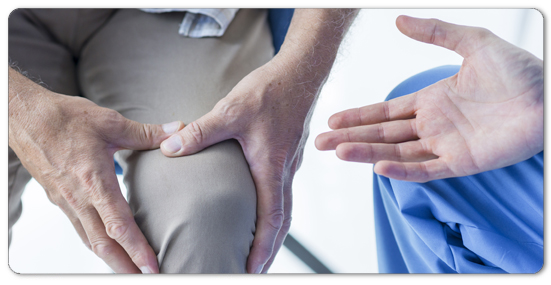Knee Arthritis
Arthritis of the knee can make taking a step painful. Swelling, pain, and stiffness in the joint are just some of the symptoms that can occur when a person has this condition. Any joint in the body may be affected by the disease, but it is particularly common in the knee.
Knee arthritis can make it hard to do many everyday activities, such as walking or climbing stairs. The knee joint is a hinge joint, named for its movement that is similar to the opening and closing of a door. It is a major cause of lost work time and a serious disability for many people.
The most common types of arthritis are osteoarthritis and rheumatoid arthritis, but there are more than 100 different forms. While arthritis is mainly an adult disease, some forms affect children.
The daily demands on the knee and its potential for injury make it a common source for arthritis damage. Different types of arthritis exist, and the type determines which treatment a physician recommends.

TYPES OF ARTHRITIS
The major types of arthritis that affect the knee are osteoarthritis, gouty arthritis, rheumatoid arthritis, and posttraumatic arthritis.
Osteoarthritis
Osteoarthritis is the most common form of arthritis in the knee. It is a degenerative, “wear-and-tear" type of arthritis that occurs most often in people 50 years of age and older, but may occur in younger people, too. It happens when the protective cartilage that covers the bones wears away.
In osteoarthritis, the cartilage in the knee joint gradually wears away. As the cartilage wears away, it becomes frayed and rough, and the protective space between the bones decreases. This can result in bone rubbing on bone, and produce painful bone spurs.
Osteoarthritis develops slowly and the pain it causes worsens over time.
Gouty Arthritis
Gouty arthritis may have several causes or risk factors.
These include:
- getting older
- having a family history of gouty arthritis
- being male, as it more often affects men
- obesity, as excess weight means there is more tissue that can be broken down into uric acid
- using certain medications
Gout often starts in the big toe. A person may also have kidney stones and lumps under the skin.
Rheumatoid Arthritis
Rheumatoid arthritis is a chronic disease that attacks multiple joints throughout the body, including the knee joint. It is symmetrical, meaning that it usually affects the same joint on both sides of the body. Doctors do not know exactly what causes RA, but genetic factors may play a role.
In rheumatoid arthritis the synovial membrane that covers the knee joint begins to swell, This results in knee pain and stiffness.
Rheumatoid arthritis is an autoimmune disease. This means that the immune system attacks its own tissues. The immune system damages normal tissue (such as cartilage and ligaments) and softens the bone.
Posttraumatic Arthritis
Posttraumatic arthritis is form of arthritis that develops after an injury to the knee, such as a sprain or a cartilage tear. A broken bone may damage the joint surface and lead to arthritis years after the injury. Meniscal tears and ligament injuries can cause instability and additional wear on the knee joint, which over time can result in arthritis.